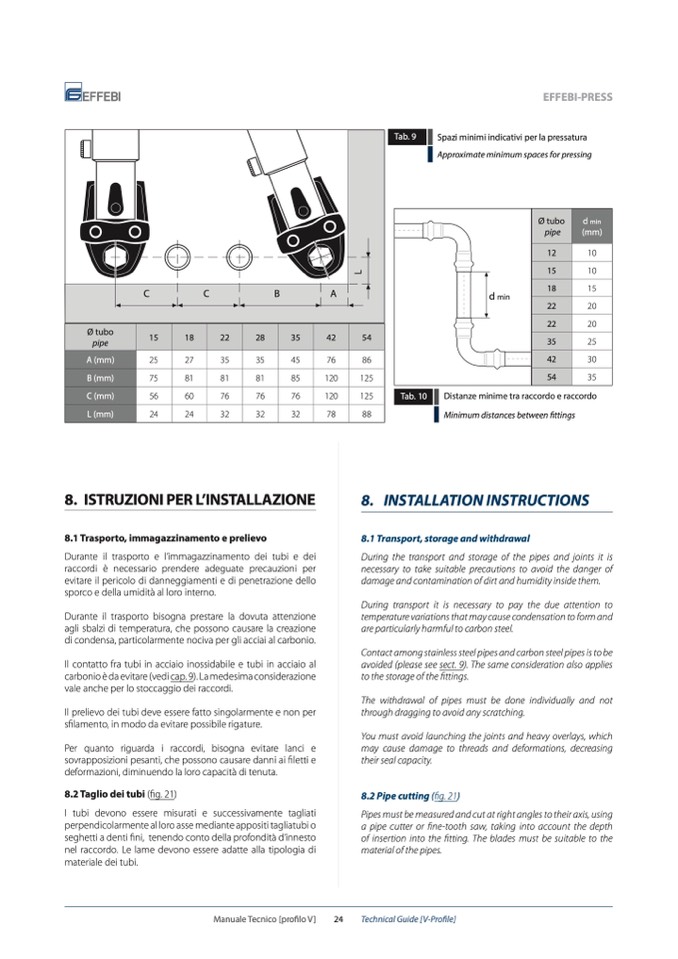
EFFEBI-PRESS
Spazi minimi indicativi per la pressatura
Approximate minimum spaces for pressing
Tab. 9
C
C
B
A
Ø tubo
pipe
15
18
22
28
35
42
54
A (mm)
25
27
35
35
45
76
86
B (mm)
75
81
81
81
85
120
125
C (mm)
56
60
76
76
76
120
125
L (mm)
24
24
32
32
32
78
88
Ø tubo
pipe
d min
(mm)
12
10
15
10
d min
18
22
15
22
20
20
35
25
42
30
54
35
Tab. 10
8. ISTRUZIONI PER L’INSTALLAZIONE
8.1 Trasporto, immagazzinamento e prelievo
Durante il trasporto e l’immagazzinamento dei tubi e dei
raccordi è necessario prendere adeguate precauzioni per
evitare il pericolo di danneggiamenti e di penetrazione dello
sporco e della umidità al loro interno.
Durante il trasporto bisogna prestare la dovuta attenzione
agli sbalzi di temperatura, che possono causare la creazione
di condensa, particolarmente nociva per gli acciai al carbonio.
Il contatto fra tubi in acciaio inossidabile e tubi in acciaio al
carbonio è da evitare (vedi cap. 9). La medesima considerazione
vale anche per lo stoccaggio dei raccordi.
Il prelievo dei tubi deve essere fatto singolarmente e non per
sfilamento, in modo da evitare possibile rigature.
Per quanto riguarda i raccordi, bisogna evitare lanci e
sovrapposizioni pesanti, che possono causare danni ai filetti e
deformazioni, diminuendo la loro capacità di tenuta.
8.2 Taglio dei tubi (fig. 21)
I tubi devono essere misurati e successivamente tagliati
perpendicolarmente al loro asse mediante appositi tagliatubi o
seghetti a denti fini, tenendo conto della profondità d’innesto
nel raccordo. Le lame devono essere adatte alla tipologia di
materiale dei tubi.
Distanze minime tra raccordo e raccordo
Minimum distances between fittings
8. INSTALLATION INSTRUCTIONS
8.1 Transport, storage and withdrawal
During the transport and storage of the pipes and joints it is
necessary to take suitable precautions to avoid the danger of
damage and contamination of dirt and humidity inside them.
During transport it is necessary to pay the due attention to
temperature variations that may cause condensation to form and
are particularly harmful to carbon steel.
Contact among stainless steel pipes and carbon steel pipes is to be
avoided (please see sect. 9). The same consideration also applies
to the storage of the fittings.
The withdrawal of pipes must be done individually and not
through dragging to avoid any scratching.
You must avoid launching the joints and heavy overlays, which
may cause damage to threads and deformations, decreasing
their seal capacity.
8.2 Pipe cutting (fig. 21)
Pipes must be measured and cut at right angles to their axis, using
a pipe cutter or fine-tooth saw, taking into account the depth
of insertion into the fitting. The blades must be suitable to the
material of the pipes.
Manuale Tecnico [profilo V]
24
Technical Guide [V-Profile]
L

